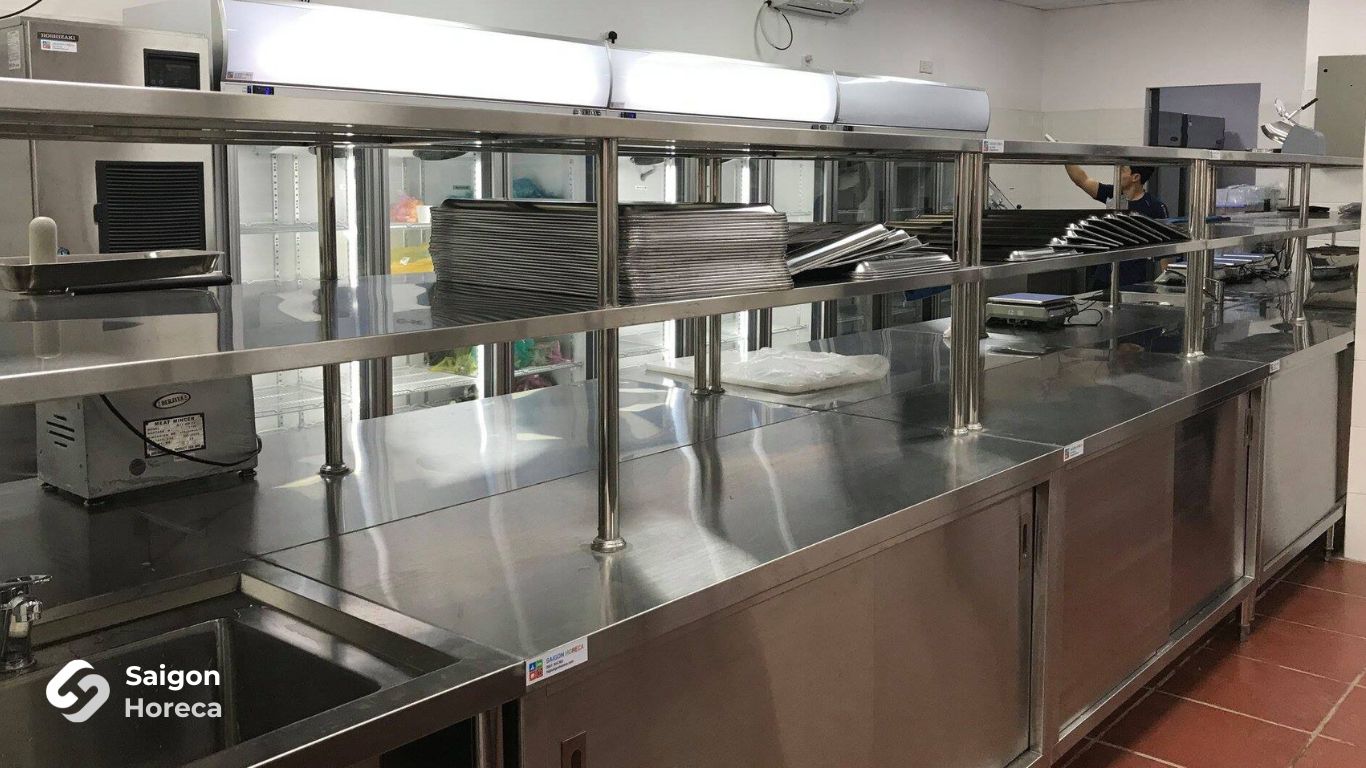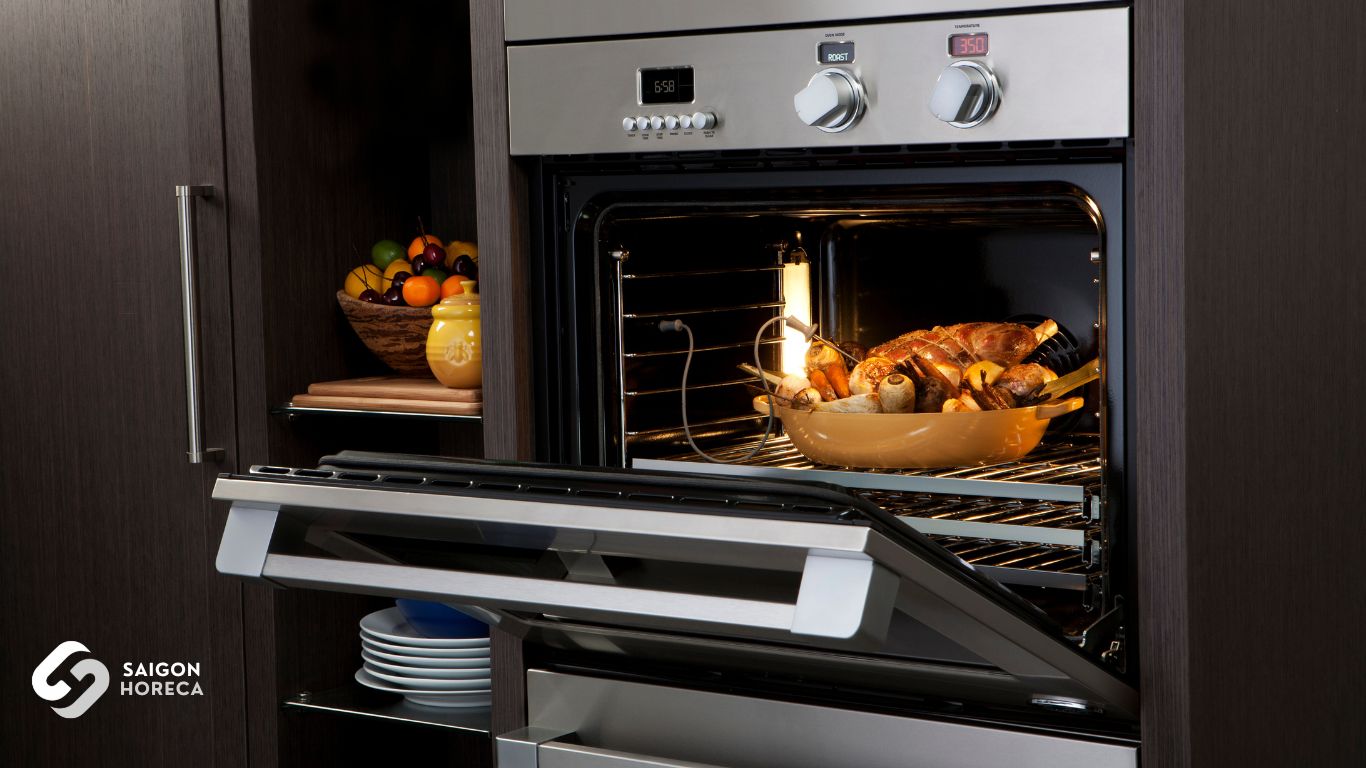In the context of the rapidly growing culinary and food service industry, investing in industrial kitchen equipment for a canteen […]
Read more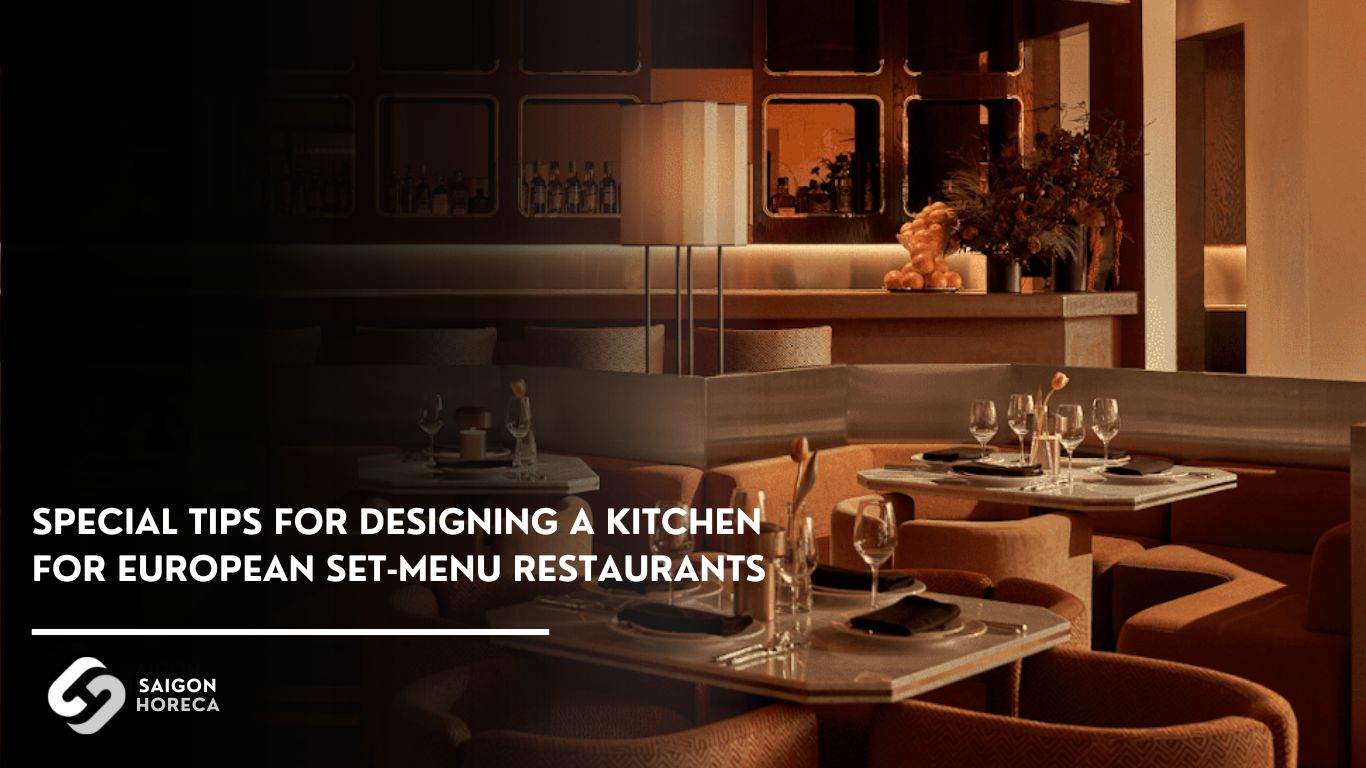

- News
Special Tips for Designing a Kitchen for European Set Menu Restaurants
- May 20, 2025
Can a European Restaurant Serving Set Menu Run Smoothly, On Time, and Consistently—If the Kitchen Design Is Flawed from the Start?
Many restaurant owners focus heavily on the food, ambiance, and service, often overlooking one key element: the kitchen design. In European restaurants—especially those operating with a set menu—the kitchen is truly the engine room behind every flawless dining experience.
Unlike other kitchen models, a European-style kitchen demands strict workflows, clearly divided stations, and tight time control. Even the smallest design bottleneck can delay service, affect the consistency of each dish, and disrupt the guest experience.
In this article, Saigon Horeca walks you through the essential considerations when designing a kitchen for a European restaurant serving set menu—critical factors that are often forgotten, yet can make or break operational success.
In this article
Unique Features of European Restaurants Serving Set Menu
In a European restaurant that follows the set menu model, guests don’t choose individual dishes. Instead, the menu is pre-planned as a fixed sequence of courses—usually including a starter, a main course, and a dessert. These dishes are served in order, and the timing between each course needs to be accurate and consistent to ensure a smooth dining experience.
Unlike casual dining models, the set menu format requires strict control over food temperature, presentation, and coordination across all tables. Guests who choose this type of restaurant are often looking for a fine dining experience, with high expectations for quality, service, and timing.
That’s why kitchen design for a European set menu restaurant is more than just placing equipment—it’s about building a highly efficient system. This system must support chefs in preparing, cooking, and serving each dish precisely and at the right moment, ensuring a premium experience for every guest
5 Key Notes When Designing a European Kitchen for Set Menu Service
Optimize the “One-Way Flow” – The Core of a Well-Designed Set Menu Kitchen
In European kitchens—especially those serving set menu—timing and rhythm are everything. Since dishes must be served in a fixed sequence, any delay in preparation or service can disrupt the entire dining experience.
To avoid bottlenecks and ensure smooth operations, a professional kitchen must follow the “one-way flow” principle. This means designing a clear, one-directional path from goods receiving → prep → cooking → plating → dishwashing. Each zone should connect logically, with minimal crossing between raw, cooked, and waste flows.
For restaurants offering European-style set menu, poor kitchen layout can cause major problems during peak hours—slow dish turnaround, confused staff, and long waits for guests. That’s why optimizing kitchen workflow is essential. A streamlined layout not only improves efficiency but also helps maintain the highest service standards for every course delivered.


Essential Functional Zones in a European Restaurant Kitchen
In a European kitchen, every dish is a blend of refined culinary techniques—from roasting and pan-searing to sauce-making and desserts. That’s why it’s critical to divide the kitchen into clearly defined functional zones, avoiding overlap between processes.
- Cold Kitchen – Prep & Storage Area
This is where ingredients are received, sorted, and prepped before entering the main kitchen. It’s typically located near walk-in coolers or industrial refrigerators and fully separated from the hot kitchen to ensure food safety and hygiene.
- Hot Kitchen – Main Cooking Area
The heart of the operation, this zone includes the European stove, deep fryer, combi oven, salamander, and stock pot range. It requires a strong ventilation system and a smart layout to allow smooth movement between cooking stations and avoid congestion.
- Plating Station – Finishing Touches
This is where the final presentation of dishes takes place. Equipped with heat lamps and warming shelves, this zone must be kept separate from ingredient flow and the dishwashing area to maintain dish quality and visual appeal.
- Dishwashing & Sanitation Area
Designed with a one-way workflow, this area separates raw and cooked item cleaning zones. It is integrated with odor and wastewater management systems to keep the entire kitchen hygienic and compliant with safety standards.
A well-zoned kitchen not only enhances workflow but also ensures consistent quality and efficient service—key goals for any professional European restaurant.


Time Synchronization – A Kitchen That Runs Like Clockwork
In a restaurant kitchen serving set menu, time is not just a factor of operation—it’s a key ingredient in the dining experience. A set menu leaves no room for delay: the appetizer, main course, and dessert must be served in the correct order, at the right temperature, and at the right moment. A single late dish can disrupt the entire rhythm of the meal.
To achieve perfect timing, the kitchen must operate like a finely tuned machine. This requires seamless coordination between the cooking line, plating area, and service team.
Key Elements That Keep Time in Sync:
- Pass Line (Plating Counter): Acts as the bridge between kitchen and service. It ensures dishes are checked, organized, and sent out in the correct sequence.
- Heat Lamp: Keeps hot dishes warm while waiting to be served, without compromising quality or texture.
- Chiller Drawer: Maintains cold desserts at the right temperature, allowing chefs to prepare in advance while preserving freshness.
In addition, the head chef must have a clear line of sight across the kitchen to coordinate dish timing for each table. This can only happen when the kitchen is designed for easy observation, smooth movement, and uninterrupted flow of plated food.
A professional set-menu kitchen doesn’t just cook well—it runs on time, delivering a smooth, consistent experience from the first bite to the last.
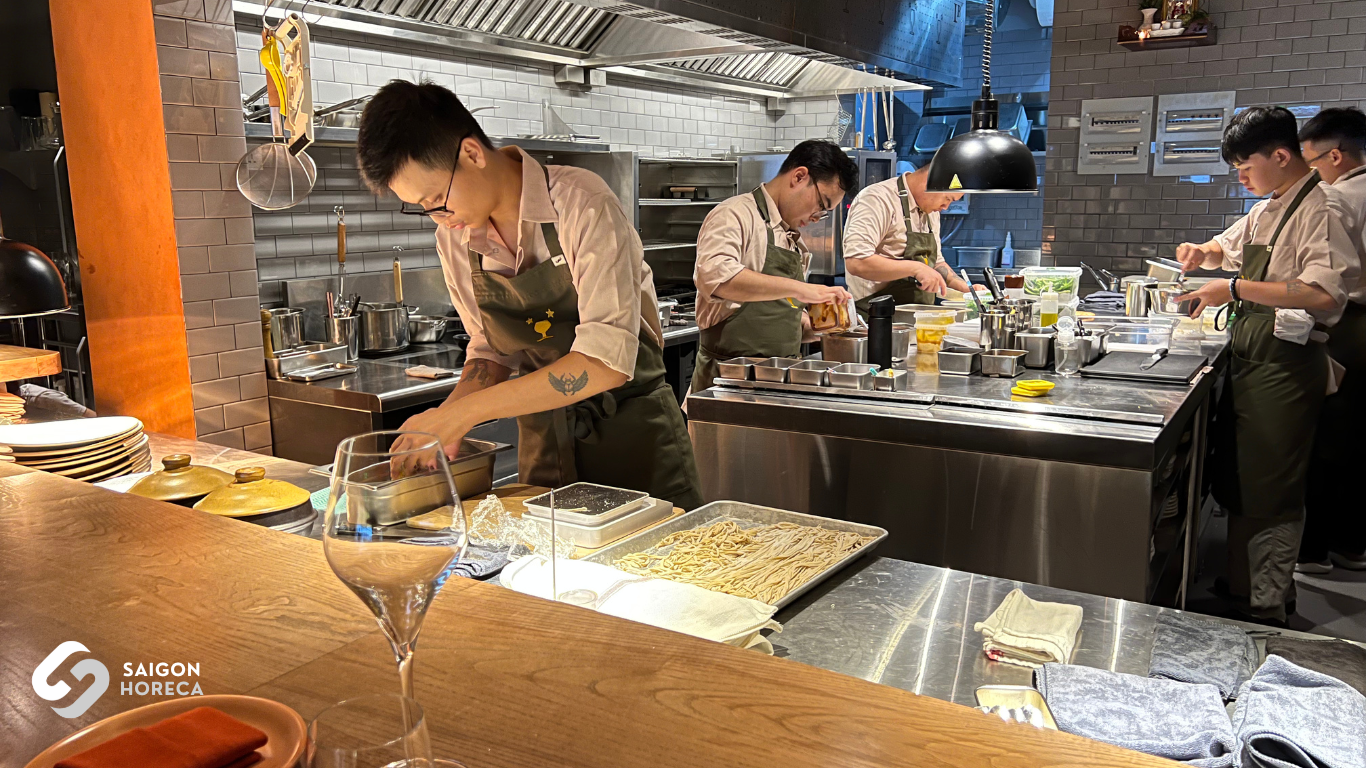

Human-Centered Design – Empowering Chefs to Work Efficiently
A well-designed kitchen is not just about smooth workflow or architectural aesthetics—it must first and foremost serve the people who work in it. During peak hours, every second counts, and chefs must move with speed, safety, and precision.
In a high-pressure restaurant kitchen, even minor design flaws can lead to major consequences: back pain from low counters, restricted movement due to cramped equipment, or loss of focus caused by excess heat and noise.
Key Design Principles That Support Kitchen Staff:
- Ergonomic Worktop Height: Standardized counter height allows chefs to work comfortably, reducing musculoskeletal strain and increasing overall productivity
- Optimal Spacing Between Equipment: Ensures enough room for chefs to move freely while keeping all tools and stations within easy reach. This minimizes collisions and confusion during busy service periods.
- Efficient Ventilation & Heat Extraction: Especially critical in closed kitchens where multiple heat sources operate at once. A strong exhaust system helps regulate temperature, improves air quality, and keeps the team focused and energized.
At the end of the day, a great kitchen is one where chefs feel in control of their environment—where every design element supports their performance, creativity, and long-term well-being.
Safety and Hygiene: The Foundation of a European Kitchen
In the design of a European restaurant kitchen, safety and hygiene are not secondary concerns—they are the very foundation of efficient operation. With Western cuisine emphasizing finesse in both flavor and presentation, even the slightest trace of odor, cross-contamination, or damp conditions can ruin the dining experience.
That’s why every decision about kitchen layout and equipment must be made with hygiene control as a top priority:
- Stainless Steel Surfaces: Corrosion-resistant, easy to clean, and ideal for humid, high-temperature environments. Stainless steel minimizes bacterial growth and ensures long-term cleanliness.
- Built-In Floor Drainage: Prevents water accumulation, reduces slipping hazards, and keeps the kitchen floor dry and safe.
- Waste & Odor Management Systems: Concealed bins with sealed lids and effective exhaust systems help eliminate lingering food smells and maintain a fresh kitchen environment.
- Dedicated Washing Stations: Separate sinks for raw ingredients and cooked utensils reduce the risk of cross-contamination and meet food safety standards.
A clean kitchen is the starting point for delicious food—this is a core principle in every professional European restaurant. Only when hygiene and safety are integrated from the design stage can the entire operation behind each dish remain strong, stable, and sustainable.
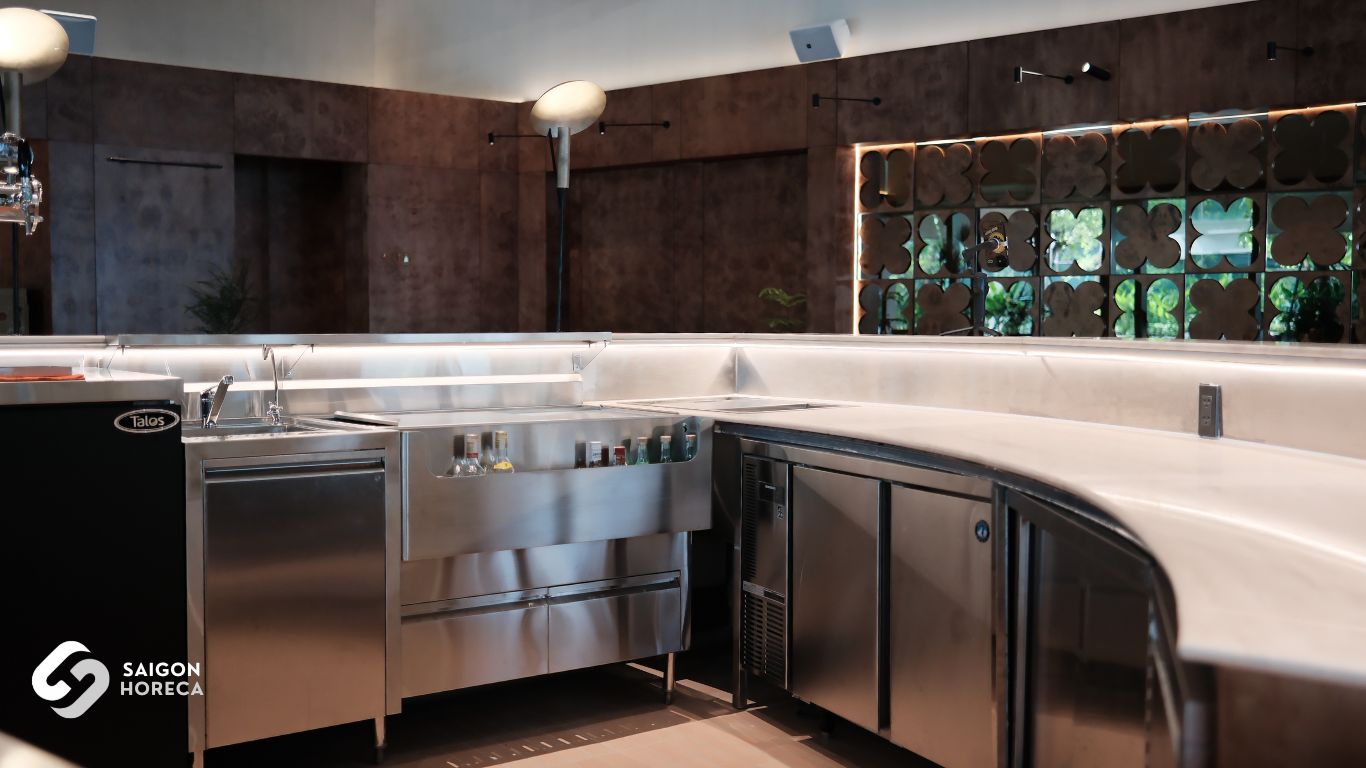

Kitchen Design – The Key to Success for European Set Menu Restaurants
A well-planned kitchen layout can reduce staffing costs, enhance service quality, and deliver a consistent dining experience to every guest. It’s not just about “installing equipment”—it’s about building a fully synchronized operational ecosystem where every movement is efficient, coordinated, and optimized in real time.
Saigon Horeca is proud to be the trusted partner of hundreds of restaurants and hotels in designing and building professional European-standard commercial kitchens. With over 10 years of experience, our team of engineers and specialists pays close attention to every detail—from technical drawings to on-site implementation—to deliver safe, sustainable, and high-performance solutions tailored to each business model.
If you’re looking for a professional kitchen design solution for your European-style set menu restaurant, Saigon Horeca is ready to provide full-service support—from concept to operational launch.
Monday - Friday
from 8h00 to 18h00
40 Street No. 6, Melosa Garden, Phu Huu Ward, Thu Duc, HCMC
Contact anytime
Looking to elevate your grilled dishes with a Salamander Grill? With its ability to grill quickly and evenly while giving […]
Read more
